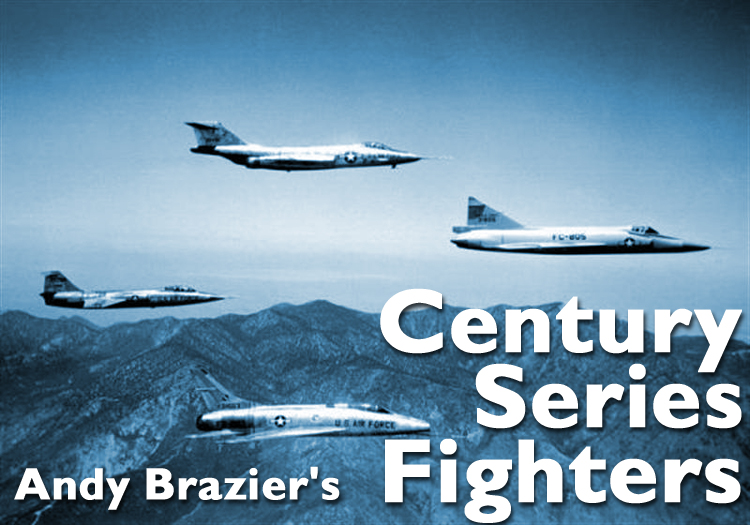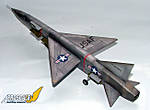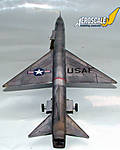Century Series Fighters Pt. 4
2
Comments
Republic XF-103 Thunderwarrior
The YF-103 was an even more high-performance interceptor being developed by Republic Aviation at the same time as the F-102. The YF-103’s design was challenging in that the airframe was to have been constructed primarily of titanium alloys. These new materials were necessary for the aircraft to achieve its exceptional performance requirements. In order to achieve speeds in excess of Mach 3, the XF-103’s propulsion system was a combination of turbojet and ramjet engines. The F-103 was “so radical, so advanced, and incorporated so many unproven components” that many engineers doubted it would ever reach production. By early 1953, the program had become an “experimental weapon system,” and no FY1954 funds were allotted for an extended development program. In 1957, the program was cancelled altogether.In 1949, the USAF issued a request for an advanced supersonic interceptor, known as the "1954 Interceptor" project, or Weapon System WS-201A. It was to be a supersonic aircraft with all-weather capability, radar and air-to-air missile armament. Republic was one of six companies to submit proposals. On 2 July 1951 three of the designs were selected, Convair's scaled-up XF-92, a Lockheed design and Republic's AP-57.
AP-57 was an extremely advanced design intended to be built almost entirely of titanium, capable of speeds up to Mach 5 at altitudes of at least 80,000 ft (24,400 m). To provide such performance, it was intended to have a Wright J67 turbojet (a license-built derivative of the Bristol Olympus engine) supplemented by an RJ55-W-1 ramjet. At "low" speeds the ramjet was turned off and the aircraft was powered by the J67 and its afterburner. At high speeds, starting above Mach 2, the jet engine would be shut down and the ramjet would be lit, utilizing a series of fold able, movable ramps allowing the air to go over the jet engine and directly into the ramjet. The ramjet operated solely at high speed. At full power, with both the jet engine in afterburner and ramjet, the engines provided nearly 40,000 lb thrust in a 55,000 lb gross weight aircraft, which would have yielded spectacular acceleration and climb performance. Both engines were fed by a ventral Ferri intake, which featured a prominent, swept-forward lip, a design feature employed on the Republic RF-84F and later F-105.
All of the control surfaces were pure delta wings. The main wing was swept at 55 degrees, and could be rotated around the spar to provide variable incidence. For takeoff and landing, the wing was "tilted up" to increase the angle of attack while keeping the fuselage more horizontal in order to improve visibility. The system also allowed the fuselage to fly "flat" to the airflow at various speeds, setting the trim angle independent of the aircraft as a whole. This decreased trim drag and thereby improved range.
The wing was "cut" at about two-thirds of the span, the portion outside of this line able to rotate independently of the rest of the wing in order to act as large ailerons, or as Republic referred to them, "tiperons". In order to keep the surface areas in front and behind the pivot point somewhat similar, the "cut line" was closer to the fuselage in front of the pivot. Large conventional flaps ran from the fuselage to the tiperons.
The horizontal stabilizers were seemingly undersized, and mounted below the line of the wing. The larger vertical fin was supplemented by a ventral fin for high-speed stability, which folded to the right (as seen from behind) during takeoff and landing to avoid hitting the ground. Two "petal" style air brakes were mounted directly behind the horizontal surfaces, opening out and up at about a 45 degree angle into the gap between the horizontal and vertical surfaces. A provision for a breaking parachute is not evident on the mock-up or the various artwork, although this was a common addition for aircraft of the era.
The fuselage was completely smooth, with a high fineness ratio for low drag at supersonic and hypersonic speeds. The design was developed prior to the introduction of the area rule, and does not display any of the "wasp wasting" common to aircraft primarily developed after 1952. The fuselage contours were mainly cylindrical, but blended into the intake starting around the wing root, giving it a rounded, rectangular profile through the middle, before reverting to a pure cylinder shape again at the engine nozzle. The cockpit design originally featured a canopy, but low drag requirements for high speed required that the canopy be removed. A new design was proposed with the cockpit completely buried in the fuselage, with only two windows on the side for direct viewing, and a periscope providing forward visibility housed in a "mini canopy" on top. In 1955, the periscope concept was tested on a specially modified F-84G, which was flown on a long, cross-country flight with the pilot's forward vision blocked. The XF-103 was not the only aircraft to use this sort of arrangement, as the Avro 730 high-speed bomber used a very similar system.
A unique supersonic escape capsule (SEC) was designed for the XF-103. In an emergency the entire cockpit area would be ejected below the aircraft, along with a small portion of the fuselage that created a stable shape at high speeds. To enter and exit the aircraft, the ejection module was lowered on rails out of the bottom of the aircraft, allowing the pilot to simply walk into the seat, sit down, and raise the module back up. During an emergency, a shield stored in front of the seat would slide up into place in front of the pilot, sealing him into the SEC formed out of the shield and the seat back. Only the basic flight instruments were included in the "normal" cockpit area, most of the equipment was mounted around the pilot on the inside of the fuselage. The SEC was fully pressurized, allowing the pilot to continue operating the aircraft without a pressure suit when the capsule was "locked up".
The entire nose of the aircraft was taken up by the large Hughes radar set, which offered (what was then) long detection ranges. Guidance and fire control were to be provided by the same MX-1179 package being developed for all of the "1954 Interceptor" designs. Hughes had won this contract with their Hughes MA-1 fire control system, which was under development at the time. Weapons were carried in bays located on the sides of the fuselage behind the cockpit, which opened by flipping upward and thereby rotating the missiles out of their bays. It was to be armed with six GAR-1/GAR-3 AIM-4 Falcon (then still known as the MX-904), with a likely arrangement of three GAR-1 and three GAR-3s fired in radar/IR pairs to improve the odds of a hit, or four GAR-1/GAR-3 AIM-4 Falcons, with a likely arrangement of two GAR-1 and two GAR-3s fired in radar/IR pairs, with two larger nuclear-tipped missiles, which may have evolved into the GAR-11/AIM-26 Super Falcon. The XF-103 also was to feature 36 x 2.75-inch "Mighty Mouse" Mk 4/Mk 40 Folding-Fin Aerial Rockets (FFAR).
A full-scale mock-up was built and inspected in March 1953. A contract for three prototypes followed in June 1954. Work on the prototypes was delayed by continued problems with the titanium construction, and more notably by continued problems with the engine. The contract was later reduced to a single prototype. In the end, the J67 never entered production and the aircraft that had chosen it were forced to turn to other designs, or were cancelled outright. Continuing delays and cost overruns caused the XF-103 program to be cut back to only one prototype. Republic suggested replacing the J67 with the Wright J65, a much less powerful engine, entirely unrealistic for an aircraft of this size. The project was eventually cancelled on 21 August 1957 with no flying prototypes ever being completed.
General characteristics
Crew: one pilotLength: 77 ft (23.5 m)
Wingspan: 34 ft 5 in (10.5 m)
Height: 16 ft 7 in (5.1 m)
Wing area: 401 ft² (37.2 m²)
Empty weight: 24,949 lb (11,317 kg)
Loaded weight: 38,505 lb (17,466 kg)
Max takeoff weight: 42,864 lb (19,443 kg)
Powerplant: 1× Wright XJ67-W-3 turbojet, 15,000 lbf (66.7 kN) 1× Wright XRJ55-W-1 ramjet, 18,800 lbf (83.6 kN)
Performance Maximum speed: Mach 3 (as a turbojet) / Mach 5 (ramjet-only)
Service ceiling: 80,000 ft + (24,390 m +)
Rate of climb: 19,000 ft/min (5,800 m/min)
Wing loading: 96 lb/ft² (470 kg/m²)
Thrust/weight (jet): 0.57:1 (afterburner only); 0.95:1 (afterburner and ramjet)
Combat radius: 245 mi (394 km)
Ferry range: 1,545 mi (2,486 km)
Armament 36 × 2.75-in (70 mm) FFAR rockets and 6 × GAR-1/GAR-3 AIM-4 Falcon
or
4 × GAR-1/GAR-3 AIM-4 Falcon missiles 2 × Nuclear-Tipped air-to-air missiles
Information from Wikipedia.
The model
1/72nd scale Anigrand Craftworks resin kit. Sprayed with Alclad II paints. A inbox review of this kit can be found here.Comments
Definitely looks as though it was inspired by or inspired the Thunderbirds.
Also looks like it's related to the "Snark"
Another great build Andy, to remind us of the old Smoker Birds.
AUG 27, 2007 - 10:26 AM
Thanks Rowan and Chuck.
Whilst reasearching the XF-103 I came across the Snark and I did wonder to myself how much it influenced the Thunderwarrior design.
The Snark is better looking as well.
Andy
AUG 27, 2007 - 10:35 AM
Copyright ©2021 by Andy Brazier. Images also by copyright holder unless otherwise noted. The views and opinions expressed herein are solely the views and opinions of the authors and/or contributors to this Web site and do not necessarily represent the views and/or opinions of AeroScale, KitMaker Network, or Silver Star Enterrpises. Images also by copyright holder unless otherwise noted. Opinions expressed are those of the author(s) and not necessarily those of AeroScale. All rights reserved. Originally published on: 2007-08-27 00:00:00. Unique Reads: 15441




















